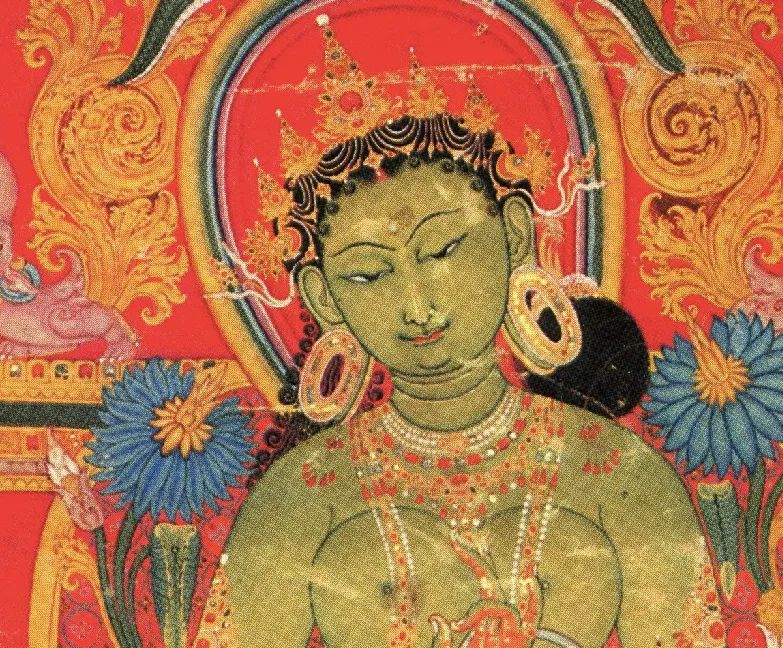
Green in Himalayan art: Glittering green light like Tara
Interested in our green tara statues, amulets and thangkas?
Please click on the link - green tara

Green Tara, early 13th century, Cleveland Museum of Art
The goddess residing in the sandalwood forest is known as Green Tara
She is the combined form of all the Taras (goddesses)
Light green is the color of the sixteen-year-old girls in South Asian literature
The girls often gather and dance under the shade of the trees
The sunlight shines on their beautiful bodies and turns them green

Partial: Green Tara's Countenance (Newar Style)
The two common green Tara practices are
the "Six-Armed Green Tara" by Nairatmya (གཉལ་ལོ་)
and the "Kashmiri Scholar Tara" by Kashmiri scholars.

Local: Vegetation within the Purple Sandalwood Grove
In some early texts, within the sandalwood forest, one can experience the changing of the four seasons in a day (similarly in other Buddhist gardens).
Therefore, in artistic creations, the greenery of the four seasons is slightly different.
The green of spring is lake green,
the green of summer is emerald green,
the green of autumn is embroidered green (moss green),
and the green of winter is yellow green.

"Unfulfilled Achievements at the Altar of the Buddha City"
14th century, private collection
The Northern main Buddha Vairochana achieves his Buddha body in green color
In South Asian classics, it is referred to as "peacock green"
In Tibetan classics, it is specifically referred to as "turquoise green" (སྤང་ཀྱུ་མ་)
All achievements come from breaking through poison obstacles
Ultimately becoming a green wisdom vessel (accomplished body)
Therefore, green also symbolizes toxicity (internal and external)

Partial: Buddha's body color is not empty accomplishments

"The Heavenly King Vaishravana with a Club Statue"
15th century, private collection
As the Northern Buddha King
Dhritarashtra, the figure of the Dharma Protector Dhritarashtra is generally depicted in green
He is also known as the "Mountain-colored Protector" (རྣམ་སྲས་རི་བོའི་ཚོན་)
He decorates himself with the skin of the dragon race
Hence this deep green color is known as "Serpentine Green" (ལྗང་སྦྲུལ་)
Green is the combination color of the four activities.

Localized: Celestial King's Countenance

Local: Dragonkin Attendant
Dragon species have toxic qualities (primarily venomous).
Therefore, the toxic body of the dragon species is called "Green Body" (ལྗང་གཟུགས་).
The toxic spots on their bodies in the art world
are called "Green Residue" (ལྗང་སེགས་).
སྔོ་ལྗང་གཉིས་པོ་ཚོན་གྱི་ཡུལ་ལྗོངས་ཡིན།
སྐྱིད་ཉམས་འདོད་ན་དེ་ཡི་ནང་ལ་ཡོད།
Green and blue, two beautiful colors,
If painting a happy land, use green and blue.
(A saying in the Tibetan art world)
*In the artistic tradition of Tibet, green is the witness of art history.
In the Karma Kagyu school of painting, green landscapes are divided into
"Indian green landscapes" and "Chinese green landscapes".
ལྗང་གུ་ཚོན་གྱི་ཨ་ཁུ་ཡིན།
སུ་དང་ཕྲད་ཀྱང་དེ་ལ་ཕན།
(……)
གཡུ་ཆེན་སྤང་རིགས་ས་གཞིར་དབང།
སྤང་དཀར་སྤང་སྔོན་སྤང་སེར་རིགས།
ཉིན་གྱི་རི་ལ་དབང་བ་ཡིན།
སྤ་ཤུག་གཡུ་ཁ་ལ་སོགས་པ།
སྲིབ་ཀྱི་རི་ལ་དབང་བ་ཡིན།
སྤང་ལྗང་གཡུ་ལྗང་སྤང་སྔོན་རྣམས།
ཉིན་སྲིབ་ཐུན་མོང་མཚམས་ལ་གནས།
རི་ཐང་མཚམས་དང་ཆུ་འགྲམ་གྱིས་
ས་ཤས་སྤང་རྩྭ་མ་སྐྱེས་དབྱིབས།
ཧུ་ལྗང་ཇ་ཁའི་མདངས་ལ་དབང།
The green color is the color of my uncle
Meeting with anyone is always beneficial
(…)
Deep jade and many shades of green on the earth
Light green, blue-green, and yellow-green
The land of sunny mountains has its own colors
Pine green, emerald green, and other hues
The land of shaded mountains has its own colors
Emerald green, grass green, and blue-green
The colors on both sides of the mountains are suitable
If there are overlapping mountainous areas
Or sparse grass by a lake
Then use lake green and tea green
- Dima Geshe Dainzeng Pengcuo
དེའུ་དམར་དགེ་བཤེས་བསྟན་འཛིན་ཕུན་ཚོགས་
(1672-?)
* The so-called "deep jade" is peacock green
While "pine green" refers to leaf green
In the color study of Tibet, "tea green" generally refers to olive green

"Thirteenth Gyalwang Karmapa", 19th century, Rubin Museum
The Thirteenth Dalai Lama Thubten Gyatso (1733-1797) was a highly talented painter and art researcher whose studies of color theory were crucial for the Tibetan region.

The color of mountain sunshine

The color of mountain shade

The Karmapa in creation
If red is the color of rebirth and convenience, then green is the color of life and wisdom, the color of the wind. In native culture, green belongs to the "Lu Shen" (dragon clan in Buddhist context), and "green people, green horses" is the core vocabulary that describes these aquatic beings in ancient memories. Green is the color that easily absorbs essence, and it is the vessel in which different spiritual bodies can coexist in the universe (similar to the soul stone in Tibetan culture).
In Tibetan color theory, green is commonly represented by the Tibetan letter "4" (༤), but can also be indicated by the Tibetan words "lja" (ལྗ་) or "jng" (ཇང་). In addition to green, there are two other branches of green colors, which are grass green (སྤང་/abbreviated as སྤ་) and jade green (གཡུ་/abbreviated as ཡུ་). The color of mountains, water, stones, and grass; green fills the spaces between heaven and earth. As the famous 19th-century painter Lumbeng Kheshe from Dzogchen Monastery once taught, artists should be cautious when using green, as "the green seen by the human eye is already extraordinary, and if the artist lacks enthusiasm, the painting will be as poor as copying nature."

"Symptoms of Illness: Dragon Species", 17th Century, Rubin Museum

"Lucky Heavenly Mother Offering Image"
18th century, Los Angeles County Museum of Art
In this painting of the auspicious Tibetan mother goddess, every aspect from background structure to the presentation of elements perfectly showcases the significance of green in Tibetan art.

Local
The two dragons on both sides control clouds of different colors.
The flesh-colored dragon on the left controls misty clouds.
The emerald green dragon on the right controls raining clouds.
In some rituals related to the deity Guanyin, there is a description of the "Six Green Dragons" in Tibetan as ལྗང་འབྲུག་དྲུག་.

Local
With this, the introduction to the "Five Primary Colors" in Tibetan color theory finally comes to an end. In the next two articles on color theory, I will focus on pigments, color combinations, and coloring techniques in Tibetan color theory. I will use specific artworks to illustrate the diachronic changes and synchronic characteristics (regional variations) in Tibetan color theory.


